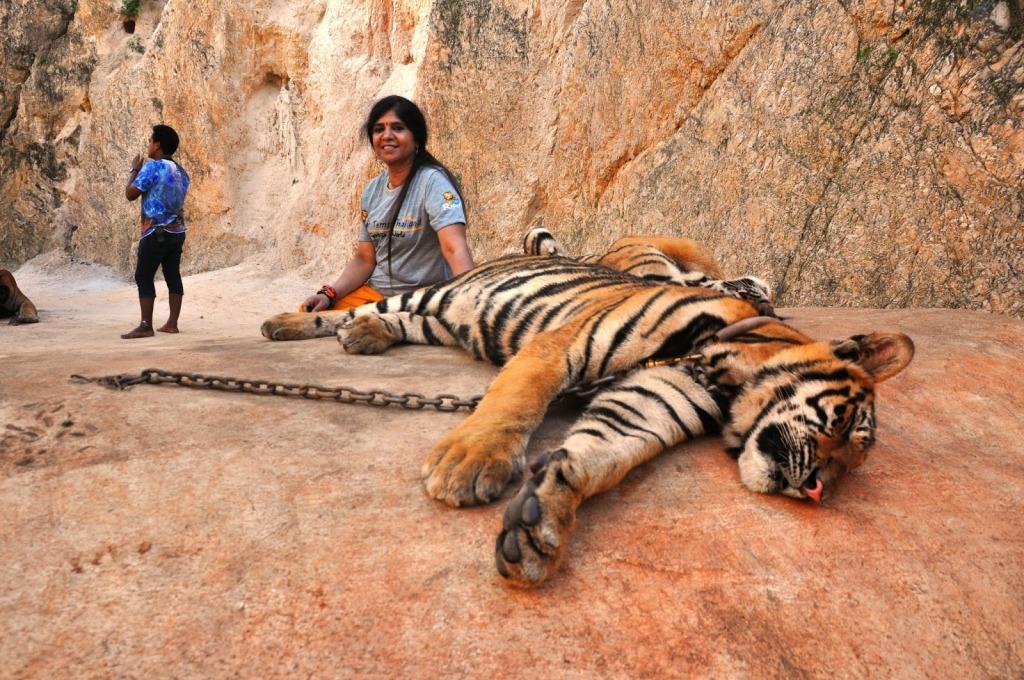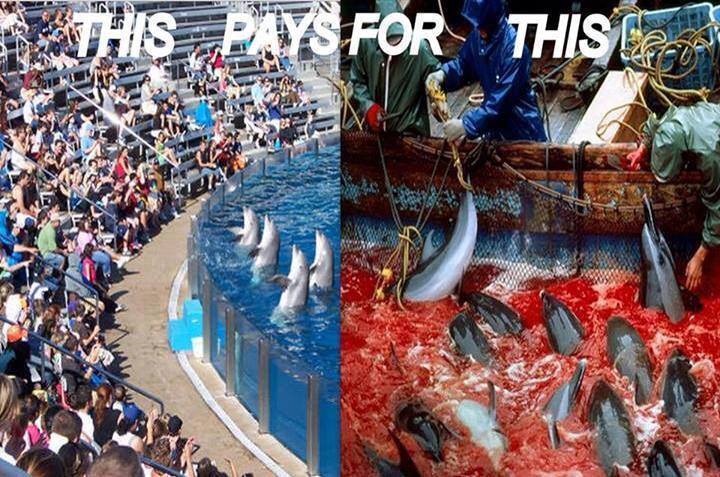Common tourist mistakes
Tiger templesMany people go to Thailand on holidays and get their photo taken with tigers not knowing the truth about the abuse and wildlife trade going on behind closed doors. There are many so called Tiger temples in Asia and if you just think about it for a while and ask yourself these questions:
The Temple began in 1999, by the acquisition of 8 tigers, 4 male 4 female through a Laos tiger trader. The tigers were purchased through the illegal wildlife trade and the tigers were never rescued orphans. In 2002, the tigers were officially confiscated off the Temple by Dept of National Parks, Thailand (DNP) and the Temple was ordered to neither trade nor breed. The DNP allowed the tigers to stay at the temple as no facilities were available to re-home the tigers. Between the years 2002 - 2010 numerous tigers have disappeared and older tigers or feisty tigers are traded or swapped with new cubs. New cubs are given the name of the traded tigers name to present a front that all tigers are still there. The abuse is violent and rampant in all areas - diet, exercise, enrichment, veterinary care etc. On a return visit in 2010 there are 76 tigers within the temple in outside Bangkok, Thailand and with the scientific tiger stripe ID the proof is undeniable. It is estimated another 75 tigers have come and gone through the gates of this so called Buddhist Temple, lost to the wildlife trade. The tigers live in small decrepit cages. Inside these cement cells, most of the tigers live there 24 hours per day, 7 days per week. The exception is the dozen or so tigers, the young ones, which are taken to a canyon area for 4 hours, for public display and handling, for photographs, for money. They are then returned to their cement cells. The tigers and other animals endure immense long term suffering with illnesses and injury going untreated, sometimes resulting in death. There are approximately 2500 adult breeding pairs of tiger left in the wild on our earth, but that number is falling rapidly. The captive wildlife trade is directly linked to this as the adult tigers are killed in the wild, the cubs taken to tiger farms to be grown for the illegal and violent traditional medicine industry, and for the vanity for those who think it is a status symbol to own a tiger fur mat, or tiger fur item. So, why are these Tiger temples still legal? The very high powered people support the Temple would never allow the money to disappear. This is one of the best tourism money spinners in this area. What can I do? Spread the word out about this place into the world and let people know that this is a place of wildlife trade, that when tourists walk through the gates of the temple and pay their money, that they are inadvertently contributing to the illegal wildlife trade and death of these creatures. I doubt that any decent person would go if they knew this information. I hope that with communication and education, this place could become a miracle in the making. However to get rid of the illegal elements involved in this place is a mighty task. We need to continue to pursue the education and communication channels, because I still have hope that if the abusive and trade elements are removed, and if the temples can be turned into a place of national pride, this would no doubt set a precedent, and send a blazing message out to other places that Thailand and Laos will no longer tolerate wildlife trade of their beautiful creatures in their beautiful country. If that can happen, that would be miraculous. And I do hold that hope I always have. So what do you do when you know that these tigers are dying in vain, for no reason, except greed. Do you sit and say nothing? Do you sit back and say "It's not my country so I shouldn't interfere"? If we did that, then today there would be many more species extinct, both plant and animal, land sea and air. Get inspired, make changes and educate others! |
Riding on elephantsAsian elephants are an endangered species. Experts believe there are now less than 2000 wild elephants living in Thailand. The population is declining at a rapid rate due to loss of habitat.
Illegal capture and trade for use in the tourism industry is also a big problem. This industry thrives because foreign visitors all want to ride elephants, or watch them do tricks, paying good money for the privilege. But the fact is that wild elephants need to be tamed before they can be ridden. Except the taming process in Southeast Asia is not the same as with a wild horse. It’s much more brutal, and is accomplished when the elephants are very young. Wild elephants won’t let humans ride on top of them. So in order to tame a wild elephant, it is tortured as a baby to completely break its spirit. The process is called Phajaan, or “the crush”. It involves ripping baby elephants away from their mothers and confining them in a very small space, like a cage or hole in the ground where they’re unable to move. The baby elephants are then beaten into submission with clubs, pierced with sharp bull-hooks, and simultaneously starved and deprived of sleep for many days. Elephant mistreatment doesn’t stop after they’ve been tamed. Many elephant camps continue to employ bull-hooks to control the animals. While they may not be stabbing them constantly like they did in training, it’s the fear of being stabbed that’s used to motivate them to work. Elephants never forget. If an elephant camp in Southeast Asia is claiming to be “responsible” with it’s animals, you should still be skeptical. Remember the process used to train them is often the same, even if they’re treated with kindness now. And usually there is no way to be sure. Did you know that riding elephants can actually cause serious long-term harm too? Their spines are not made to support the weight of humans. Brutal elephant training has been a traditional practice in Southeast Asia for hundreds of years. The problem these days is that most captive elephants in Thailand are used to entertain tourists rather than for traditional purposes like logging or military use. It’s our demand for elephant rides and circus acts that leads to more baby elephants getting captured from their mothers, tortured, and sold off to entertain us. Most people who participate in elephant tourism in Thailand are completely unaware of how they are treated. |
Visiting SeaWorldAquariums and marine-mammal theme parks like SeaWorld are part of a billion-dollar industry built on the suffering of intelligent, social beings who are denied everything that is natural and important to them.
Wild orcas and dolphins live in large, complex social groups and swim vast distances every day in the open ocean. In captivity, these animals can only swim in endless circles in tanks that are the equivalent of bathtubs, and they are denied the opportunity to engage in almost any natural behavior. They are forced to perform meaningless tricks and often torn away from family members when they’re shuffled between parks. Most die far short of their natural life spans. Most dolphins in captivity are from Taiji, Japan. There is a six-month annual hunt season and those cetaceans who are not ruthlessly killed in front of their family are sold to captive facilities in Taiji or elsewhere around the world, doomed to a life of imprisonment. During the hunt, entire pods of dolphins and pilot whales are driven to the shallow waters of Taiji’s infamous cove, swimming wild and free before they are forced to flee the nearly inescapable “wall of sound” created by the engines of the hunting boats and metal poles struck against the sides of the vessels. Once netted within the cove, the dolphins face one of two horrific fates – brutal slaughter before the eyes of their family members or a lifetime of imprisonment in captivity. The captive selection process takes place simultaneously to the slaughter, as killers and trainers work side-by-side to select the “prettiest” dolphins (those without visible scars) and tear them away from their family pod for captivity. The newly captive cetaceans are trained and conditioned to eat thawed dead fish, sometimes being force-fed by trainers. They are sold to dolphinariums and marine parks in Japan or overseas, transported in tiny, dark, coffin-like crates sometimes for thousands of miles. These highly intelligent and socially complex marine mammals, taken from their expansive ocean home, are not well suited for captivity, where they are forced to live in small barren tanks and to perform tricks for noisy crowds in order to be fed dead fish. Their natural environment, their natural behaviors, and the right to live in their natural family groupings are denied to them. It is widely believed that Taiji’s drive hunt could not be sustained solely by the sale of dolphin and pilot whale meat for human consumption. As the demand for the meat sinks to an all-time low, it is clear the hunt is increasingly a result of the demand for live cetaceans to be sold in the lucrative captive trade – the economic “fuel” that drives the hunting boats in search of pods. Just one captured and trained dolphin can be sold by the hunters for as much as $250,000 USD. |




